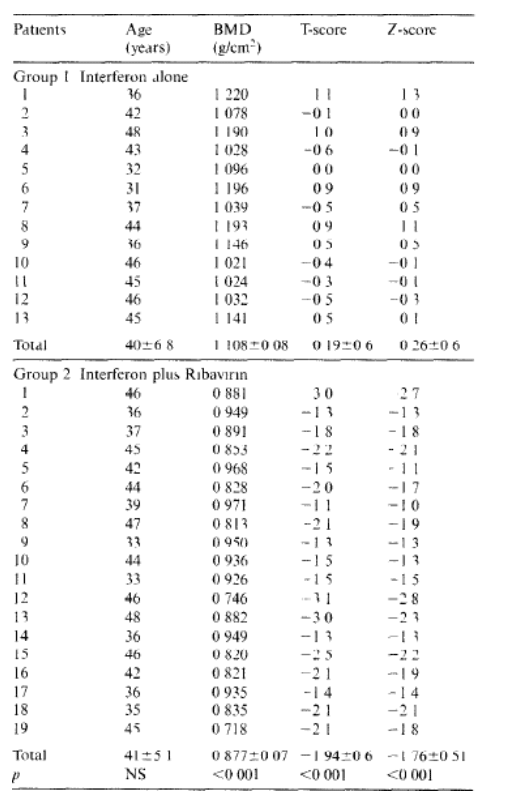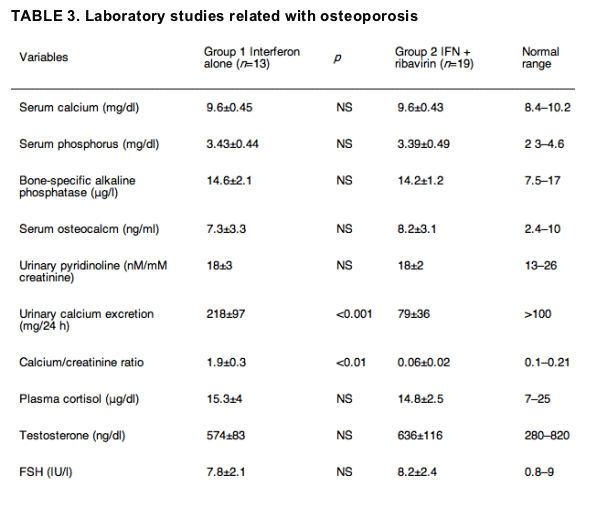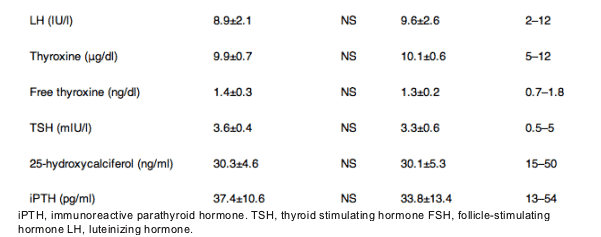| |
Decreased bone mineral density after therapy with alpha interferon in combination with ribavirin for chronic hepatitis C
|
| |
| |
Journal of Hepatology Nov 2000
Jose A Solis-Herruzo1, Gregorio Castellano1, Inmaculada Fernandez1, Raquel Munoz1, Federico Hawkins2
Received 13 August 1999; received in revised form 24 February 2000; accepted 10 May 2000.
"We conclude that treatment of chronic hepatitis C with combined therapy for 12 months may cause a reduced BMD in almost all patients Although this study does not definitely prove that this treatment was the cause of the reduced bone mass found in this group of patients, we believe that physicians should be aware of the risk of this potential secondary effect of the antiviral therapy..... A survey among male patients, aged between 31 and 48 years, who had been treated with either IFN alone or IFN plus ribavirin for 12 months, showed that only patients on combination therapy displayed low bone densitometry T-and Z-scores..... The T-score values were in the normal range in group 1 (0.19±0.6) None of them had T-scores under -1.0. Four of the 19 patients treated with this combination had T-score values below -2.5, that is, in the range of osteoporosis. None of them presented symptoms of bone fractures. The remaining 15 patients showed T-score values between -1.0 and -2.5, that is, in the range of osteopenia."
Ribavirin (l_-D-ribofuranosyl-1H-1,2,4 triazole-3-carboxamide) is a water-soluble, synthetic guanosine analogue that exerts a broad spectrum of activity against several DNA and RNA viruses, including viruses of the flaviviridae family 1, 2. Randomized, placebo-controlled studies have shown that therapy of chronic hepatitis C with ribavirin for 24 to 48 weeks resulted in a reduction in serum alanine aminotransferase (ALT) levels 3, 4, 5, 6. However, patients remained viremic and ALT levels returned to pretreatment levels when therapy was stopped (4). Combination therapy of ribavirin with alpha interferon (IFN) has been demonstrated to be more effective than IFN alone in inducing virologic and histologic improvement 7, 8, 9. Ribavirin is generally well tolerated. Its major adverse effects are hemolysis and nonspecific symptoms of fatigue, depression, insomnia, vertigo, anorexia, nausea, nasal congestion and pruritus 10, 11. Although, there is little information about the effect of the combination of ribavirin plus IFN on bone mineral density (BMD) and bone turnover in patients with chronic hepatitis C, back pain and bone fracture have been reported in some patients (11).
In this paper we report the case of a male patient treated with ribavirin plus IFN for 12 months, who developed severe osteoporosis in the absence of any other cause of osteoporosis. A survey among male patients treated for 12 months with IFN alone or in combination with ribavirin showed that osteopenia or osteoporosis was a common finding among patients treated with the combination of both antiviral agents, but not in patients treated with IFN alone. (from Jules: as I have said NRTIs might cause mitochondrial toxicity in bone cells).
Discussion
Although a few patients have so far been reported to develop bone fractures or back pain during therapy with ribavirin plus IFN (11), little attention has been paid to such events and no study has been published concerning the effect of this therapy on bone mineral metabolism. In this paper, we report the case of a male patient treated with IFN plus ribavirin who presented several episodes of back pain. A bone densitometry of the lumbar spine demonstrated T-scores and Z-scores in the range of osteoporosis according to the World Health Organization definitions (15). In addition, a magnetic nuclear resonance examination of the spine showed a decreased BMD, expansion of the intervertebral spaces with herniation of the intervertebral disk into the T4 vertebral body (Fig 1). Studies to determine the cause of this reduced bone mass had negative results. There was no suggestion on history or physical examination of hypogonadism, hyperthyroidism, gastrointestinal disease, Cushing's syndrome, malignancy or other pathologic processes. He had never abused alcohol, had never smoked or taken medications involved in the etiology of some cases of osteoporosis (corticosteroids, anticonvulsants, heparin immunosuppressive agents, thyroid hormone, chemotherapeutic agents, methotrexate, lithium). He maintained normal physical activity and weight. Serum levels of testosterone, cortisol, gonadotropins thyroxine, TSH, iPTH, 25-hydroxycalciferol, serum protein electrophoresis and immunoelectrophoresis, as well as 24-h urinary-free cortisol excretion and fecal fat were normal.
Although we cannot definitely rule out osteoporosis being present prior to the antiviral therapy, the fact that no signs of osteopenia could be identified on an X-ray examination of the chest performed 2 years earlier leads us to suggest that bone loss was induced during the ribavirin-IFN treatment. A survey among male patients, aged between 31 and 48 years, who had been treated with either IFN alone or IFN plus ribavirin for 12 months, showed that only patients on combination therapy displayed low bone densitometry T-and Z-scores. T-score values, that measure the departure of the patient's BMD value from the mean BMD for a young adult population in units of the population standard deviation, were significantly lower in the group of patients on combination therapy (-1.94±0.6) than in the IFN group (0.19±0.6, p<0.001). Likewise, Z-score, that uses as reference the mean BMD and standard deviation for a healthy age-matched population, was also lower in the IFN-ribavirin group (-1.76±0.5) than in the IFN group (0.26±0.6, p<0.001). These observations support the suspicion of an etiologic relationship between the combination therapy and osteoporosis. However, since these observations do not definitely prove this relationship, a prospective study comparing BMD, biochemical markers of bone turnover and secondary osteoporosis prior to and after 12 months of treatment with either IFN alone or IFN combined with ribavirin is currently in progress.
Possible mechanisms of bone loss during ribavirin-IFN treatment are not known. Biochemical markers of bone formation (serum osteocalcin and bone alkaline phosphatase) and resorption (urine pyridinoline) were in the normal range and, therefore, no evidence of an increased bone turnover was found. However, 24-h urinary calcium excretion and urinary calcium/creatinine ratio were markedly decreased and correlated significantly with Z-and T-score values. These results suggest that either an intestinal malabsorption of calcium or vitamin D deficiency might account for an impaired intestinal calcium intake and a loss of the bone mass, although serum levels of 25-hydroxicalciferol and fecal excretion of fat were normal. Examination of small intestine biopsy specimens demonstrated a normal structure. Antigliadin and antiendomysial antibodies were negative. We speculate that ribavirin treatment might have interfered with the intestinal transport of calcium. However, new studies are mandatory to elucidate the mechanisms of this possible secondary deleterious bone effect of combined treatment of IFN with ribavirin.
We conclude that treatment of chronic hepatitis C with combined therapy for 12 months may cause a reduced BMD in almost all patients Although this study does not definitely prove that this treatment was the cause of the reduced bone mass found in this group of patients, we believe that physicians should be aware of the risk of this potential secondary effect of the antiviral therapy.
Abstract
Background/Aims: Several thousand patients with chronic hepatitis C have been treated with interferon plus ribavirin. After observing a male patient who developed severe bone loss during this treatment, we studied skeletal status and bone mineral metabolism in patients on therapy with interferon plus ribavirin.
Methods: Bone mineral density and biochemical bone markers were studied in 32 male patients (31-58 years old) treated for 12 months with either interferon alone (group 1; n=13) or interferon plus ribavirin (group 2; n=19).
Results:
Bone mineral density was significantly lower in group 2 (0.877±0.07 g/cm2) than in group 1 (1.108±0.08 g/cm2, p<0.001).
Likewise, T- and Z-score values were also decreased in group 2 (T: -1.95±0.6. Z: -1.76±0.51) compared with group 1 (T: 0.19±0.6; p<0.001. Z: 0.26±0.6; p<0.001). Serum and urine biochemical bone markers were normal in both groups. However, urinary calcium excretion was decreased in patients on combined therapy.
Conclusion: Treatment of chronic hepatitis C with interferon plus ribavirin may induce bone loss. This secondary effect should be investigated during the followup of these patients, since they may require therapies aimed at prevention or amelioration of these defects.
Case Report
A 55-year-old male physician with chronic hepatitis C was referred to our hospital to be included in a trial of combination therapy with IFN and ribavirin. In 1984, high levels of serum aminotransferases were found in a routine blood test. There was no history of alcohol intake, intravenous drugs, tobacco or medication, but, due to his profession as a health care worker, he had been exposed to needlestick on several occasions. He felt well and remained asymptomatic for the next 11 years. In 1995, he continued to be asymptomatic and a physical examination was normal. The liver was not palpable, and no ascites, splenomegaly, peripheral edema or other stigmata of chronic liver disease were found. Liver enzyme tests showed only slightly increased serum levels of ALT (50 IU/l to 89 IU/l. Normal values <45 IU/ml). Hepatitis B surface antigen was negative, anti-HCV (ELISA II) and HCV-RNA (polymerase chain reaction) were positive. The HCV-RNA serum level (Amplicor HCV Monitor; Roche Molecular System, Basel, Switzerland) was 1 300 000 copies/ml and the HCV-genotype was 1b. Serum autoantibodies (anti-nuclear, anti-mitochondial, anti-smooth muscle, anti-liver-kidney-microsome) were undetectable. Other hematological and blood chemical values were normal. A radiological examination of the chest was normal. No evidence of vertebral fracture or signs of bone loss were found. Liver biopsy showed chronic hepatitis without cirrhosis with a Histologic Activity Index score (12) of 8. He was treated with IFN (3 MU tiw) and ribavirin (1000-1200 mg/day) for 1 year. Although this combined therapy normalized serum aminotransferase levels, HCV-RNA remained positive at the end of treatment (2300 copies/ml).
In the last 6 months of treatment, he presented three episodes of severe and acute back pain without signs of spinal cord compression. Physical examination was negative except for slight tenderness over the lumbar spine. Magnetic resonance imaging of the lumbar spine showed a reduced signal intensity within the vertebral bodies with herniation of the intervertebral disk into L4 (Fig. 1) Lumbar spine densitometry showed T-score values ranging between -2.64 and -3.61 (mean value, -3.13) and Z-score values between -2.09 and -3.01 (mean value, -2.54). Biochemical markers of bone turnover were as follows serum bone alkaline phosphatase, 10 _g/l (normal values, 7.5-17 _g/l); serum osteocalcin, 7.2 ng/ml (normal values, 2 4-10 ng/ml), urinary calcium, 40 mg/24 h (normal values, >100 mg/24 h); urinary calcium/creatinine ratio, 0.034 (normal values, 0.1-0.21), urinary pyridinoline, 16 nM/mM creatinine (normal values, 13-26 nM/mM creatinine), serum calcium, 9.7 mg/dl; serum phosphorus, 3.4 mg/dl. Other variables that were measured included the following: plasma cortisol (8 a.m.), 8 _g/dl (normal values, 5-25 _g/dl); follicle-stimulating hormone (FSH), 8.6 IU/l (normal values, 0.8-9 IU/l); luteinizing hormone (LH), 11.2 IU/l (normal values, 2-12 IU/l); testosterone, 561 ng/dl (normal values, 280-820 ng/dl); immunoreactive parathyroid hormone (iPTH), 23 pg/ml (normal values, 13-54 pg/ml); total thyroxine, 10.2 _g/dl (normal values, 5-12 _g/dl); free thyroxine 1.1 ng/dl (normal values, 0.7-1.8 ng/dl); thyroid-stimulating hormone (TSH), 2.3 mU/l (normal values, 0.5-5 mIU/l); 25-hydroxycalciferol, 24 ng/ml (normal values, 15-50 ng/ml); ferritin, 109 ng/ml (normal values, 30-250 ng/ml); transferrin saturation, 14% (normal values <45%); IgG, 835 mg/dl (normal values, 500-1200 mg/dl); IgA, 165 mg/dl (normal values, 50-350 mg/dl; IgM, 90 mg/dl (normal values, 30-230 mg/dl), urinary excretion of cortisol, 66 _g/24 h (normal values, 26-135 _g/24 h). IgA antigliadin and antiendomysial antibodies were negative. Fecal fat was 3 g/24 h. Microscopic examination of a small bowel biopsy specimen revealed normal architecture of the intestinal mucosa. Due to the fact that no other cause of secondary osteoporosis was found, a relationship between the bone abnormalities and the antiviral therapy was suspected. Therefore, the decision was taken to evaluate BMD and bone turnover in patients treated with antiviral therapy for more than 6 months.
Patients and Methods
Thirty-two patients with chronic hepatitis C without cirrhosis treated with IFN for 12 months were studied All were males ranging from 31 to 48 years (mean age, 40 6±6 8 years). We excluded men over 50 years old and women to avoid the effect of age and estrogen deficiency on the bone mineral metabolism. Thirteen patients had been treated with IFN alone (3 MU tiw) (Group 1), and 19 patients with IFN (3 MU tiw) plus ribavirin (1000 to 1200 mg/day) (Group 2). All patients were asymptomatic and they had no previous history of back pain or other symptoms suggesting bone fracture. None was an abuser of alcohol nor had they taken any other medication in the previous 12 months. The relevant epidemiological, biochemical and virological baseline features of the two treatment groups were similar (Table 1) We measured lumbar (L1-L4) BMD using dual-energy X-Ray absorptiometry (DX, Hologic 4500, Waltham, MA USA). Z-score and T-score were calculated and compared with age-and sex-matched normal national subjects 13, 14. Biochemical markers of bone turnover and other osteoporosis-related parameters were measured during the last week of treatment in both groups of patients using well-standardized methods. All the subjects gave informed consent, and the study was approved by the local human ethical committee.
Statistical analysis
Data are presented as the mean±SD Significant differences between groups were determined using the unpaired Student's t-test. Correlation was tested by calculating Spearman's rank-order correlation coefficient, r (two-tailed test). A p-value of <0 05 was defined as statistically significant.
Results
Bone mineral density (BMD)
The T-score values were in the normal range in group 1 (0.19±0.6) None of them had T-scores under -1.0. By contrast, T-score was significantly decreased (-1.94±0.6) in group 2 treated with IFN plus ribavirin (p<0.001). Four of the 19 patients treated with this combination had T-score values below -2.5, that is, in the range of osteoporosis. None of them presented symptoms of bone fractures. The remaining 15 patients showed T-score values between -1.0 and -2.5, that is, in the range of osteopenia. Likewise, Z-score values were significantly lower in group 2 (-1.76±0.5), than in those treated with IFN alone (0.26±0.6 p<0.001). BMD was significantly lower in patients in group 2 (0.877±0.07 g/cm2) than in patients in group 1 (1.108±0.08 g/cm2, p<0.001) (Table 2)
TABLE 2
Lumbdr (Ll-L4) BMD m patients tredted for 12 months with either
IFN nlone or with 1FN plus nbavlrm

Bone turnover
No significant differences existed between the two groups of patients concerning serum bone-specific alkaline phosphatase, serum calcium, serum phosphorus, serum osteocalcin and urinary pyridinoline excretion. However, urinary calcium excretion and urinary calcium/creatinine ratio were decreased in group 2. Urinary calcium excretion was 79±36 mg/24 h in the latter group of patients and 218±97 mg/24 h in group 1. This excretion correlated significantly with Z-score (r=0.87, p<0.001) and T-score (r=0.80, p<0.001) values in patients treated with IFN plus ribavirin. Likewise, the calcium/creatinine ratio in a morning sample was 0.06±0.02 mg/mg creatinine in group 2 versus 1.9±0.3 mg/mg in group 1 (p<0 01). This ratio showed a significant positive correlation with the Z-score (r=0.60; p<0.01) and T-score (r=0.49; p<0 05) values in patients treated with IFN and ribavirin.
Other parameters
To rule out other causes of osteoporosis, plasma cortisol, serum testosterone, FSH, LH, thyroxine, free thyroxine, TSH, iPTH and 25-hydroxycalciferol were measured in both groups of patients on finalizing treatment. As Table 3 shows, all these markers were within the normal range and showed no significant difference between the two groups of patients.


|
|
| |
| |
|
|
|